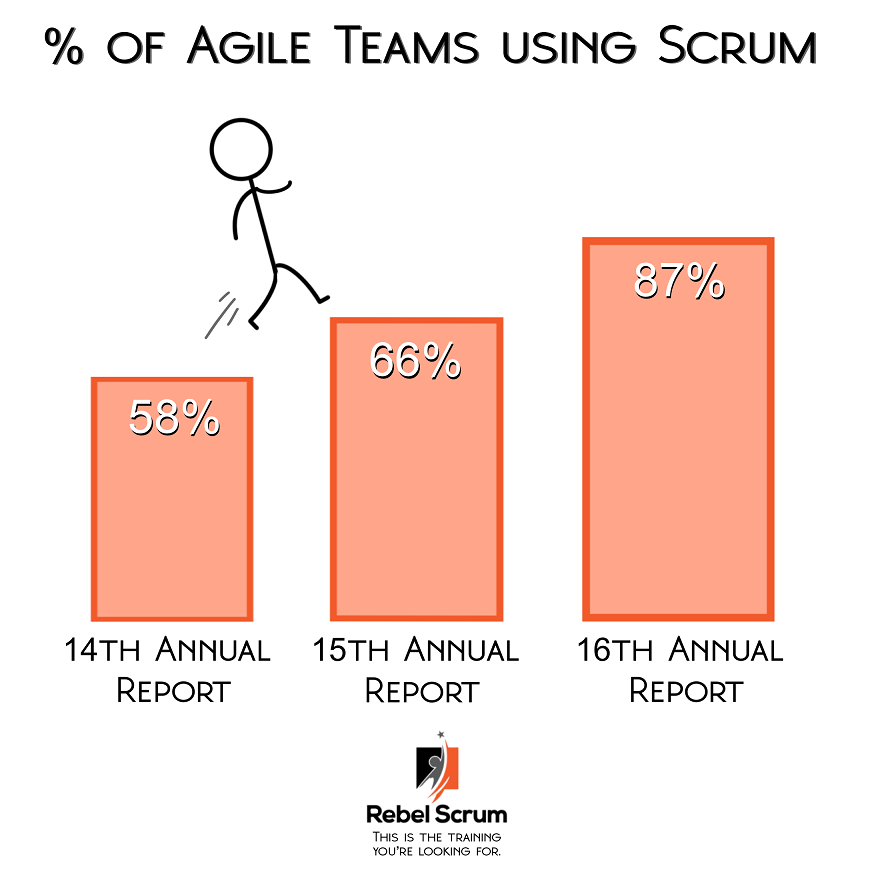Scrum is the most popular Agile framework. According to Digita.ai’s 16th annual report, 87% of organizations using an Agile framework use Scrum. That’s up from 58% of Agile teams using Scrum, as documented in the 14th annual State of Agile report.
Why is Scrum so popular?
PLM & PIM Product Owner at Wilson Sporting Goods, Dawn Augustyn, participated in one of Rebel Scrum’s recent Professional Scrum Product Owner classes. When discussing Scrum's enduring popularity, she said, “Collaboration with structure - it’s the best of both worlds!”
I couldn’t agree more. Scrum’s ability to enable collaboration through structure is one of its most significant benefits. While Scrum Team members are encouraged to work together and share ideas, there is also a designated time and a place that requires collaboration (Scrum events). As Dawn put it, “By providing an environment where everyone has a voice, Scrum helps best ideas rise to the top.”
It’s a Goldilocks framework
I think of Scrum as a Goldilocks framework. It has just enough—but not too much–structure to enable team collaboration to discover how to work most effectively.
In Scrum, everyone has a forum to provide input on how to approach the work, and it gives the people closest to the work the power to decide how much of it is reasonable in a given period (the Sprint). The team can also choose the length of the Sprint as long as it doesn’t surpass 30 days.
During each Sprint, the Scrum Team works together to deliver a potentially releasable product Increment. The team members collaborate closely, exchanging information and providing feedback to ensure they complete their work to a high standard. That Increment must meet the Definition of Done that the Scrum Team or the organization sets.
Scrum also embraces complementary practices outside the framework benefitting the team’s transparency, communication, and forecasting. Scrum Teams can find the practices that fit their specific context. This openness avoids the one-size-fits-all style of some other more rigid approaches.
It’s simple
Scrum is a framework designed to be straightforward with a compact set of accountabilities, events, and artifacts. Scrum is simple; that is its power. Scrum’s simplicity allows teams to focus on delivering value and responding to change rather than getting bogged down in complexity.
Simplicity also keeps the framework agile and adaptable, allowing teams to respond quickly to changing business problems and market conditions, create their own agendas for the events and decide how best to work together to deliver value.
Scrum reduces the overhead and administrative burden associated with product development. With a simple framework, teams can focus on delivering usable product rather than administrative tasks. Productivity improves, and the time to market for new features and products is shorter.
Because the framework is easy to understand, teams can quickly learn and get started using Scrum to deliver value and improve quality and customer satisfaction.
It’s Flexible
Scrum enables flexibility and adaptation, making it ideal for complex products with evolving or uncertain requirements. Scrum teams set their own Sprint duration, decide upon their own agenda for each of the events and decide how and where to store their Product Backlog and other artifacts. Because of this flexibility, Scrum allows teams to respond quickly to changes in customer feedback, market conditions, or other variables. Adaptability is a significant benefit, helping teams avoid delays and overcome obstacles that could slow down the project.
It’s about teamwork
Scrum’s focus on teamwork and collaboration also contributes to its popularity. The Scrum framework has specific accountabilities, such as the Product Owner, Scrum Master, and Development Team, that promote transparency, communication, and continuous improvement. This emphasis on teamwork helps to build a culture of trust, respect, and shared responsibility among team members, leading to better results.
Empiricism is powerful
Scrum implements empirical process control through its events, accountabilities and artifacts. Empiricism means that Scrum measures progress by results, not adherence to a plan. This approach allows teams to regularly inspect and adapt their outcomes and processes based on accurate information, leading to better outcomes.
Wide adaptability means expert availability
Because organizations worldwide are adopting Scrum, a large community of practitioners and experts has grown to provide support and guidance. Teams can get started with Scrum quickly and benefit from the community's collective knowledge.
Conclusion
Scrum is the most popular Agile framework because of its simplicity, flexibility, teamwork focus, empirical process control, and widespread adoption. If you're looking for an Agile framework to help you manage your products and services, Scrum is an excellent place to start.
If you are considering adopting Scrum in your organization, contact Rebel Scrum to discuss our private training options. We have access to the best trainers with experience in large-scale transformations in complex environments. If you are a leader interested in learning more about how to empower teams in your organization, signup for Rebel Scrum’s Professional Agile Leadership class.
Scrum Day
So much of what holds us back as Scrum practitioners are ways of thinking that create unnecessary barriers to value delivery. This year’s Scrum Day conference in Madison, Wisconsin, will peel back the layers blocking us from agility's benefits so that we can focus on what matters: empowering teams to deliver greater value.


